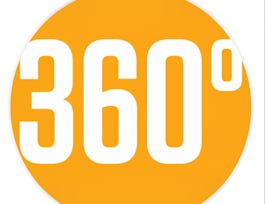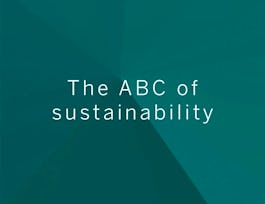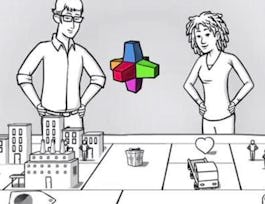Land degradation is a widespread problem across the globe with serious consequences for the environment and all of society. Worsening land degradation caused by human activities is undermining the well-being of two-fifths of humanity, driving species extinctions and intensifying climate change. But there’s a huge potential for restoring landscapes: around two billion hectares of land, about two times the size of China, can be restored.



Business Model Innovation for Sustainable Landscape Restoration



Instructors: Steve Kennedy
Sponsored by Louisiana Workforce Commission
8,038 already enrolled
(48 reviews)
Skills you'll gain
- Environmental Resource Management
- Business Consulting
- Solution Design
- Business Modeling
- Systems Thinking
- Corporate Sustainability
- Systems Engineering
- Process Design
- Process Analysis
- Environmental Social And Corporate Governance (ESG)
- Human Centered Design
- Innovation
- Natural Resource Management
- Business Analysis
- Design Thinking
- Stakeholder Engagement
- Business Process Modeling
- Entrepreneurship
- Systems Analysis
- Environment and Resource Management
Details to know

Add to your LinkedIn profile
4 assignments
See how employees at top companies are mastering in-demand skills


Earn a career certificate
Add this credential to your LinkedIn profile, resume, or CV
Share it on social media and in your performance review

There are 8 modules in this course
Welcome to this 8-week course on ‘Business model innovation for sustainable landscape restoration’! Your teachers will introduce you to the process of business model innovation, the concept of landscape restoration and to 3 real-life cases of landscape restoration projects. For each step of the innovation process, we zoom in on those landscapes to show you how the theory looks in practice. By doing this, you will apply the “4 returns” thinking (returns of inspiration, natural capital, social capital and financial capital). Week 1 introduces you to the problem of landscape degradation and the process of landscape restoration. You will also learn about the role of business models in landscape restoration and how important visions are for sustainable business model innovation. We will introduce you to our 3 practical example cases of landscape restoration. Each of these cases has encountered different problems related to landscape degradation and formulated innovative solutions by using the approach set out in this MOOC: the power of sustainable business models to successfully restore natural environments. You will choose a land degradation challenge and formulate a vision and key question.
What's included
13 videos9 readings1 assignment2 discussion prompts1 plugin
Week 2 is all about systems thinking and systems analysis. In our practical example cases you will see how diversified crop systems can help in Spain, and how birch woodlands can improve the resilience of the system in Iceland. You will learn how to conduct a systems analysis for your chosen landscape degradation challenge by identifying boundaries and key factors, creating a system map, constructing a central narrative and determining points of intervention.
What's included
6 videos6 readings3 plugins
In this week you will learn what stakeholders are and why they are important. You will see the application of the main concepts in two of our landscape examples. At the end of week 3 you can conduct your own stakeholder analysis of your chosen landscape degradation challenge.
What's included
5 videos5 readings2 plugins
In week 4 we enter the second phase of the sustainable business model innovation process: designing. In this phase we move from forming an understanding of the problem and what means we have available, to generating ideas for new business model solutions. Now you will actually start working with your stakeholders to analyse opportunities for value creation based on common goals and commitment. In week 4, the focus is on co-innovation networks and captured and destroyed value. You are going to build your co-innovation network, validate your current understandings, identify opportunities to add value and generate first business model ideas.
What's included
7 videos5 readings1 assignment
In week 5 you will learn about business models and the triple-layered business model canvas. You will also see the triple-layered business model canvas applied to all of our three cases. You reach the point now where you will select a business idea and complete your own triple layered business model canvas.
What's included
8 videos5 readings1 discussion prompt
Week 6 is about assumptions and methods and how to validate them. You will see what methods the practical example cases in Spain and Portugal used. This week then allows you to start testing your own business idea on a small scale. You will identify your own key assumptions, design the testing of those assumptions and actually test them. At the end you will iterate or pivot your business model.
What's included
10 videos4 readings1 discussion prompt
In week 7 we enter the third phase of the sustainable business model innovation process - implementing. In this phase your business model moves from being a design concept to an implemented practice that is helping to restore landscapes. We will consider how we will manage the finances, understand if we our business model is delivering its intended value, and forecast potential outcomes. We will also reflect on our constructed business models to consider how they could be scaled-up or scaled-out, and what next actions we need to take to make them a reality. You will learn about assessment and monitoring tools such as financial analysis, 4 Return Model (20 years outcomes & value creation in 3 zones), key performance indicators and scenario analysis. The cases in Portugal and Iceland serve as examples of how these can be implemented. You will make a financial analysis of your business model, set specific KPIs to measure the success of your business model for four returns in 20 years, evaluate how you can involve the stakeholders that are impacted through the 4 returns and do a Scenario Analysis.
What's included
11 videos10 readings
In this last week you will learn about key leadership principles, our Community of Practice and the nexus challenge of the SDGs. You will read about the application of concepts in practice in all of our landscapes. You will review your exercises of the past weeks, reflect about what you learned and forecast your next actions. If you want you can also connect to a global community of practitioners.
What's included
7 videos6 readings2 assignments2 plugins
Instructors



Offered by
Why people choose Coursera for their career




Learner reviews
48 reviews
- 5 stars
85.41%
- 4 stars
8.33%
- 3 stars
4.16%
- 2 stars
2.08%
- 1 star
0%
Showing 3 of 48
Reviewed on Apr 4, 2021
It was not an easy journey as it was a new area of study, but it was a joyful learning experience throughout the course.
Reviewed on Sep 28, 2021
Very manageable assignments. Quizzes are fairly easy to pass.
Reviewed on Feb 13, 2022
It was indeed one of the best online courses that I attend. Never get bored! All the optional materials were definitely worth spending time on. I highly recommend this course!
Recommended if you're interested in Business

Duke University

University of Toronto

Campus BBVA

Kennesaw State University

Open new doors with Coursera Plus
Unlimited access to 10,000+ world-class courses, hands-on projects, and job-ready certificate programs - all included in your subscription
Advance your career with an online degree
Earn a degree from world-class universities - 100% online
Join over 3,400 global companies that choose Coursera for Business
Upskill your employees to excel in the digital economy






